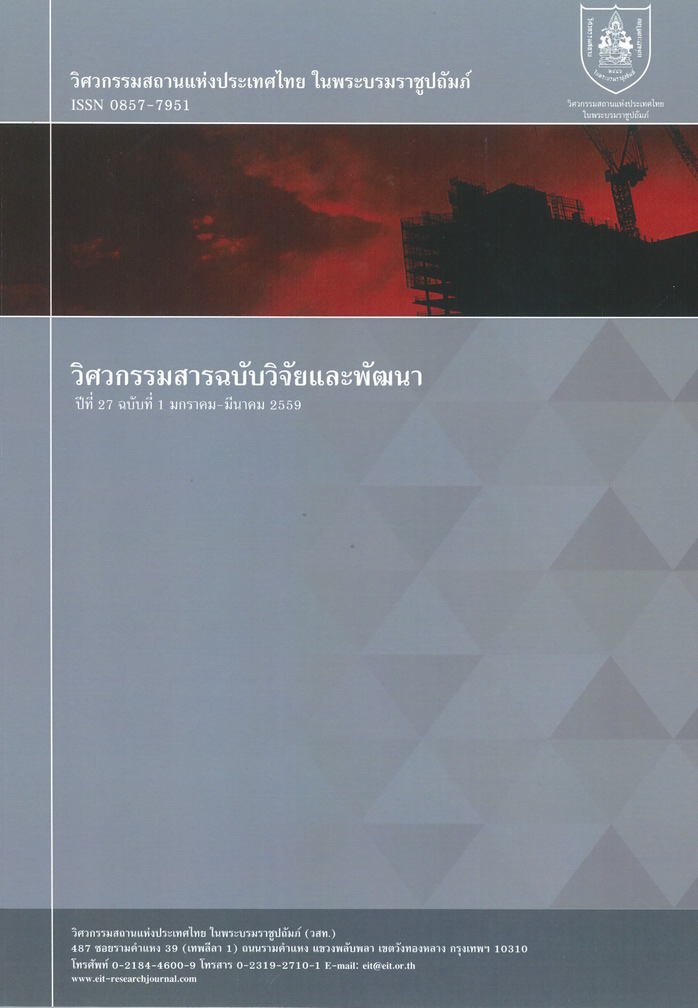PERFORMANCE COMPARISON BETWEEN 2 AND 3 IMPELLER BLADES OF THE AXIAL FLOW PUMP BY SCREW AXLE TECHNIQUE
Main Article Content
Abstract
บทความนี้ศึกษาทดลองการเปรียบเทียบสมรรถนะระหว่างใบพัด 2 และ 3 ครีบของเครื่องสูบน้ำแบบไหลตามแนวแกนโดยเทคนิคเพลาสกรู ระบบทดลองประกอบด้วยเครื่องสูบน้ำแบบไหลตามแนวแกนขนาดเส้นผ่านศูนย์กลาง 5 นิ้ว (0.12 เมตร) ยาว 8 ฟุต (3.6 เมตร) ใช้เครื่องยนต์เบนซิน Honda GX160 ขนาด 5.5 แรงม้าเป็นต้นกำลัง ใบพัดมีขนาดเส้นผ่านศูนย์กลางภายนอก 115 มิลลิเมตร เพลาสกรู ความยาว 1 เมตร ติดตั้งอยู่ที่ตำแหน่งกึ่งกลางภายในท่อทางดูด ทำการทดลองที่เงื่อนไข เฮด 1.0, 1.5, และ 2.0 เมตร ความเร็วรอบในช่วง 1500 – 4000 rpm (เพิ่มขึ้นครั้งละ 500 rpm) จากผลการทดลองพบว่า ใบพัดแบบ 3 ครีบมีอัตราการไหลและอัตราการสิ้นเปลืองน้ำมันโดยเฉลี่ยสูงกว่าใบพัดแบบ 2 ครีบ และใบพัดแบบ 3 ครีบมีประสิทธิภาพโดยเฉลี่ยสูงกว่าใบพัดแบบ 2 ครีบ ทั้งแบบไม่มีเพลาสกรูและแบบมีเพลาสกรู คิดเป็นร้อยละ 42.15 และ 67.14 โดยระบบสูบน้ำที่ทำงานร่วมกับเพลาสกรูมีประสิทธิภาพสูงขึ้นคิดเป็นร้อยละ 40 – 65 เมื่อเทียบกับระบบสูบน้ำที่ไม่มีเพลาสกรู
This article describes to investigate the performance comparison between 2 and 3 impeller blades of the axial flow pump by screw axle technique. The experimental system consists of the AFP in which diameter and length are of 5 inches (0.12 meter) and 8 feet (3.6 meter), driven by using Honda GX160 5.5HP gasoline engine, the impeller with outside diameter of 115 mm, a screw axle with the length of 1 meter installed at the middle inside the suction pipe. The experimental conditions of head are conducted at 1.0, 1.5, and 2.0 meter for the tested rotational speed in the range of 1500 – 4000 rpm with the increment of 500 rpm. From experimental results, it is found that the flow rate and fuel consumption of 3 impeller blades are higher than that of 2 impeller blades and the average efficiency of 3 impeller blades without and with screw axle is 42.15% and 67.14% higher than that of 2 impeller blades. The efficiency of pumping system with screw axle is increased by 40 – 65% when it is compared to the pumping system without screw axle.
Article Details
The published articles are copyright of the Engineering Journal of Research and Development, The Engineering Institute of Thailand Under H.M. The King's Patronage (EIT).


